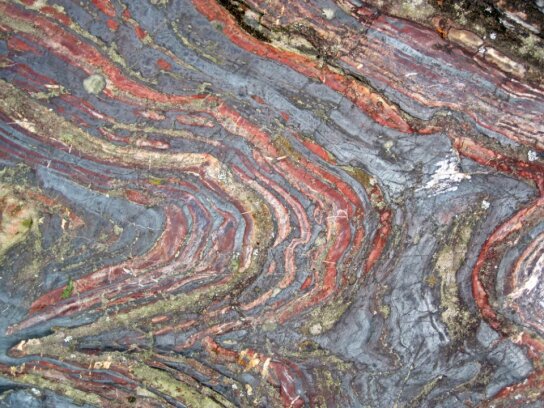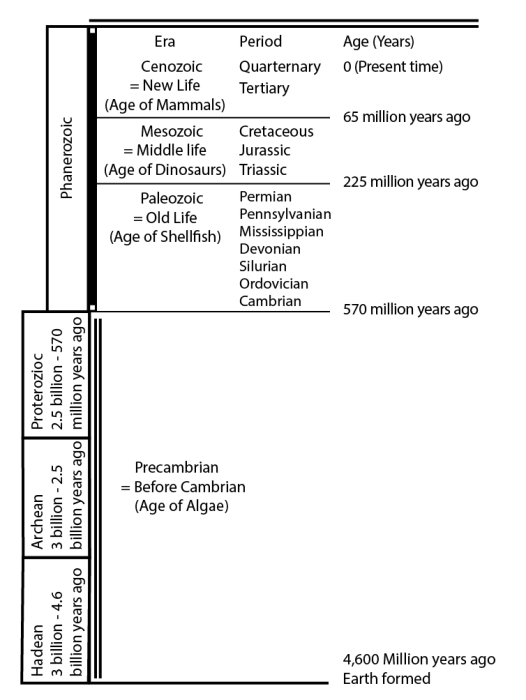Optional Enrichment Article
The Cenozoic, Mesozoic, and Paleozoic Eras are lumped together into the Phanerozoic Eon; “Phanerozoic” is from Greek roots meaning that life showed itself. The Phanerozoic started with the fairly sudden (over a few million years) appearances of common shells, which greatly “improved” the fossil record. You have to look hard to find the remains of a jellyfish in a rock, but with shells, the remains are the rock. Going back in time before the Phanerozoic are the Proterozoic (earlier life), the Archean or Archeozoic (beginning life; different people prefer to use the different words, Archean or Archeozoic), and the Hadean (like Hades; hellish).
The Hadean, from about 4.55 or 4.6 billion years to about 3.8 billion years ago, probably experienced such huge meteorite impacts that they vaporized the whole ocean and some rocks as well. Life would have had great difficulty surviving such catastrophes.
Life was present by the beginning of the Archean, about 3.8 billion years ago. The central regions of the continents had formed by the end of the Archean, about 2.5 billion years ago. Oxygen remained scarce or absent in the atmosphere and ocean, and carbon dioxide helped keep the world warm under the young sun that was not as bright as today.
In the Proterozoic, oxygen from cyanobacteria and other microbes “rusted” the oceans. Iron rusts with oxygen, but in the oxygen-poor world of the Archean, iron dissolved and washed into the ocean rather than rusting. As oxygen was released by photosynthesis, the iron was rusted and fell to the bottom to form the great banded iron formations that we mine today in Minnesota, Australia, and elsewhere.

Oxygen then increased in the atmosphere. At first, oxygen was a poison to many living things because it is so highly chemically reactive. However, oxygen proved to be highly valuable as life figured out how to use the “new” chemical, allowing the development of larger organisms. Oxygen also shields all organisms from damaging ultraviolet rays by giving rise to protective ozone in the stratosphere. As oxygen rose in the atmosphere it removed other gases from the atmosphere by combining with gases there that were stable without oxygen. Some of those were strong greenhouse gases. Back then, the sun was not as bright as it is now, and warm temperatures were maintained by an atmosphere with more greenhouse gases than today. Carbon dioxide probably was still the most important, but others including methane probably contributed more than they do today. Removal of the methane and perhaps other complex greenhouse gases may have caused the “snowball Earth” events that nearly froze the planet.

Want to see more?
What do beauty, saving money at Las Vegas, religion, oil exploration, emerging new diseases, and the planet’s recovery from global warming have in common? All in some way involve deep time, the immense age of the Earth. Eric Spielvogel filmed a discussion of these and other issues with Dr. Alley, for a special “time” issue of Research! Penn State. The Deep Time film clips on the previous page will give you something to think about, and may even help with the course. Enjoy! (No, these won't be on the quiz either!)
Sedimentation Models(link is external)
(An extensive collection of animations on this subject)
Sequence Stratigraphy(link is external)
(An extensive collection of animations on this subject)